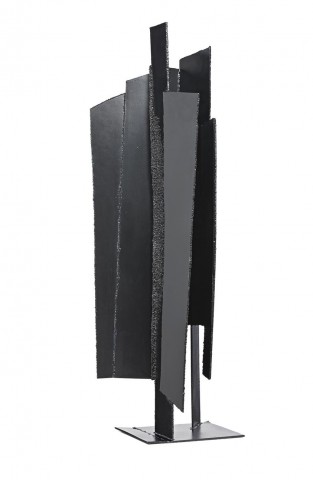UNFOLDING FORM (MAQUETTE), c.1962
INGE KING
painted steel
138.0 cm height
Mr Graham Ducker, Sydney, acquired directly from the artist
Thence by descent
Private collection, Sydney
Grishin, S., The Art of Inge King Sculptor, 2014, Macmillan Art Publishing, Melbourne, p. 367
Unfolding Form, 1962, steel painted black, 152.4 cm height, formerly private collection, Adelaide, illus. in Grishin, S., The Art of Inge King Sculptor, 2014, Macmillan Art Publishing, Melbourne, p. 94
Inge King, an émigré artist from central Europe, was so moved by the power of the Australian landscape that she sought to create sculptural works expressing her experience of this new place, resistant to and reflective of the heat and light that characterises the land. Unfolding Form (Maquette), c.1962 belongs to an important series of the artist’s non-representational welded assemblages which is characterised by the careful placement of two-dimensional planes to create tension and movement. Taking their visual cues from the prevailing idiom of contemporary constructed sculpture that was pure geometry and gestural expressionism, these works are reminiscent of those by artists such as Lynn Chadwick and Clement Meadmore, particularly his early planar constructions. Within King’s larger oeuvre, the series of planar forms lies between more organic early assemblages and the volumetric explorations of her Boulder series.
Clustered around a central vertical axis, the tightly integrated planes of Unfolding Form (Maquette) seem to do just that – unfold. Unfurling progressively like an accordion, the flat sheets of cut metal are arranged on a base to provide a myriad of disparate viewpoints. The unequal size and height of each plane creates an expanded arena in which to explore the play of light and shadow, producing effects of spatial enclosure and dissection. For King, an artist who remarkably found early public endorsement for monumental works, the creation of maquettes was central to her practice and these now account for a large proportion of her works in private collections. This version of Unfolding Form is significant, not only because it is among the last of her planar works of the early 1960s, but also because it is the last remaining example of this construction. Its related work, the larger Unfolding Form, was unfortunately destroyed by bushfires in the Adelaide Hills in 1984.1 Standing at a mere 12 cm taller than this maquette, Unfolding Form was installed en plein air, atop a naturally formed boulder.
Inspired by the work of her Melburnian peer, Lenton Parr, Inge King took up welding in 1959. Facing not insignificant public hostility to sculpture as well as a local cultural climate sceptical about abstract art, King nevertheless used this new skill to translate the liberated gestures of Abstract Expressionism into three dimensions. Edward Lucie-Smith, in his survey of modern sculpture, was careful to note that this new expressionist style was executed by sculptors with greater difficulty than it had been by painters.2 As her welding skills developed, King sought out techniques beyond her primary need to join multiple planes of sheet metal, and instead looked for ways of creating visually interesting texture. Unfolding Form (Maquette) exemplifies this achievement, in spite of its marked restriction of formal means. Balancing vertical and horizontal tension, the visibility of each plane of Unfolding Form (Maquette) relies on the contrast between smooth cut surface and raised beads of molten steel, lying along the edges of each sheet and in the recesses between them. It is through these surprising embellishments and juxtapositions that we feel the presence of the late artist – having left clear traces of her hand burnt into the metal with a fierce oxy-acetylene flame.
1. Grishin, S., Inge King Sculptor, Macmillan Publishing, Melbourne, 2014, p. 367
2. Lucie-Smith, E., Sculpture since 1945, Phaidon, Oxford, 1987, p. 44
LUCIE REEVES-SMITH
